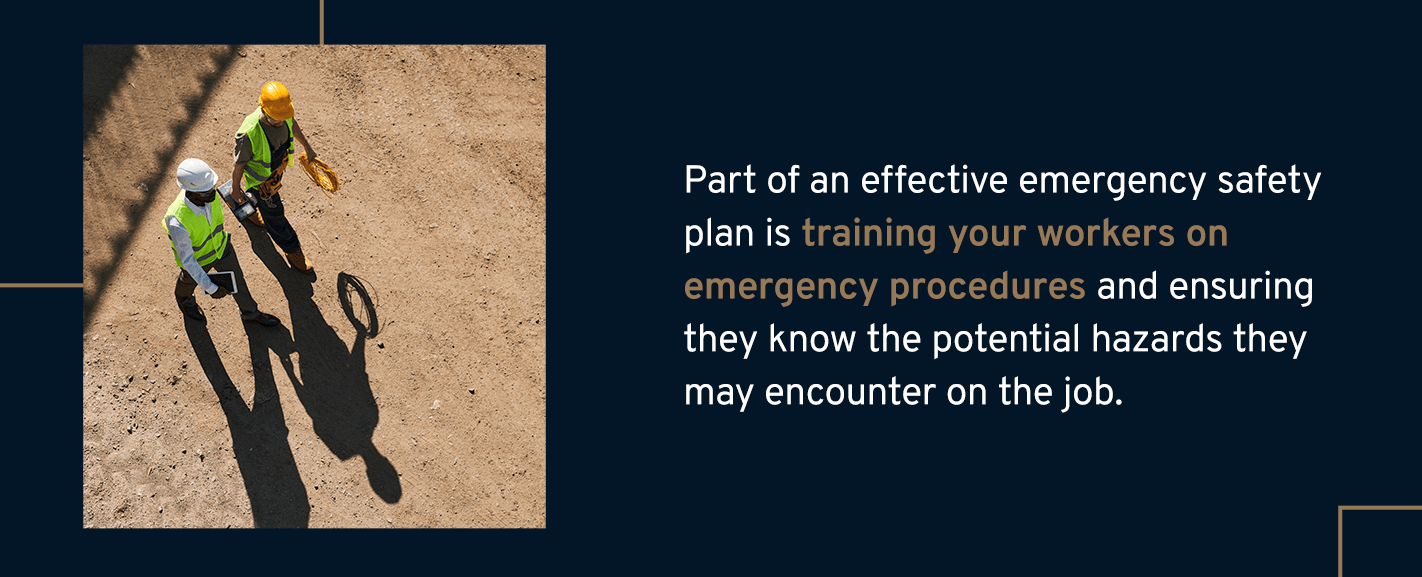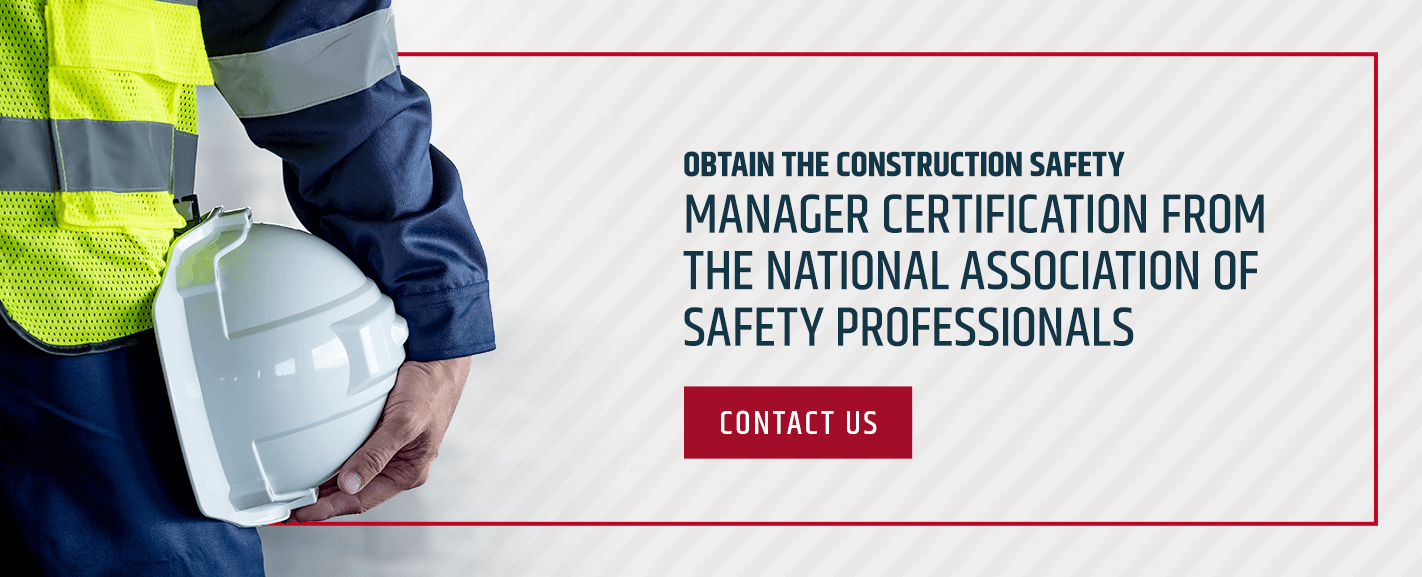Emergency Preparedness in Construction : Developing a Robust Response Plan

Construction is among the most dangerous industries in the world. Preparing for challenging and potentially hazardous work site conditions is an essential part of working in this sector. Safety professionals must establish robust emergency preparedness and response procedures for their teams to effectively minimize risks and save lives.
We are breaking down everything you need to include in a company safety plan for construction and why these protocols are essential for any contractor or business operating in this tough, high-stakes industry.
6 Steps for Developing an Emergency Safety Plan for Construction
There are two main elements of creating a comprehensive emergency safety plan — identifying proactive measures to combat risk and establishing protocols for responding to hazards in real time. Explore the following steps for creating an effective safety plan for your construction site:
1. Assess Potential Risks
The first step is identifying and documenting the potential safety risks at your job site. Consider the unique challenges and threats you may face on the job. Assess the possibilities of what could go wrong and the repercussions of those dangers. Then, use these insights to create a tailored safety plan that addresses the various hazards your workers may encounter during this project.
Also, consider any external risk factors that are outside of your control, such as climate, weather conditions, or nearby traffic. Each potential hazard should have its own mitigation and response protocols, so identifying them is a crucial first step.
2. Identify Reliable Emergency Resources
Among the most important elements of a robust health and safety plan for construction is determining where the nearest emergency resources, including fire departments, police stations, and medical facilities, are located in relation to your job site.
Connecting with local public emergency services and establishing a relationship can be advantageous in case of a crisis, especially for long-term construction projects. Ensure your entire team has access to all contact information for local authorities and resources.
3. Establish Emergency Communication Protocols
Next, develop a plan for emergency communication that includes the responsibilities of each worker in case an emergency takes place on the job.
A clear chain of command can help streamline communication and allow for faster reporting and responses. Again, anyone working on your job site should have access to all necessary emergency contact information and understand how to immediately reach response personnel.
4. Develop Procedures for Response to Specific Hazards
An important element of creating a robust emergency safety plan is establishing response protocols for specific hazards and recording them in writing for your team’s reference. Hazard communication, such as labels and other forms of chemical warnings around the job site and safety data sheets (SDSs), is also essential for helping workers avoid potential dangers and know what to do when an emergency strikes.
Your team should be versed in the unique safety risks of each job they work on, the personal protective equipment that is necessary, and their duties if they witness an accident.
5. Implement Ongoing Employee Training and Instruction
Part of an effective emergency safety plan is training your workers on emergency procedures and ensuring they know the potential hazards they may encounter on the job. Providing rigorous training sessions and safety resources can help your employees stay aware of the risks around them. It also instills confidence in them so they know what to do if an accident or crisis event occurs.
6. Assess Effectiveness and Refine Your Plan
Regularly review your emergency safety protocols to ensure they are effective in mitigating threats. Ask your team for feedback and if there are any additional hurdles they’ve faced while reacting to a specific danger or incident. Continuously find new ways to refine these practices and keep your team equipped to handle whatever the job throws at them.
The Importance of Emergency Preparedness in Construction
The construction industry is home to many serious and potentially life-threatening hazards, including falls, equipment-related injuries, asbestos, and electrocutions. Having an emergency preparedness plan can help your business with the following:
Prioritizing Worker Safety
Ensuring worker safety is essential for any construction job. Without proper protocols in place, your business cannot provide a secure and comfortable working environment. Every construction business should aim to minimize risks and create a culture of accountability wherein each person understands their unique responsibilities in contributing to the safest job sites possible. Your workers are your most valuable resources, and their lives should always be the top priority.
Protecting Your Assets
Another key reason why your business should always establish robust emergency response plans and employee training initiatives is to protect your assets. Heavy equipment, attachments, and other tools are among the largest investments a construction business will make. Proper safety protocols help ensure operators are vigilant and follow operational guidelines to reduce the risk of equipment accidents, fires, or breakdowns. A safe job site is good news for your business and your wallet.
Managing Risks and Maintaining a Positive Reputation
Emergency preparedness plays a key role in managing risks and giving your business a competitive advantage in the industry. Construction business stakeholders and potential clients want to know your operations are secure and properly managed. You can demonstrate your commitment to safety, project success, and financial stability by keeping safety protocols at the forefront of every job.
Ensuring Operational Continuity
An unexpected accident, even an instance when no worker endures harm or injury, can wreak havoc on your business’s operations. These disruptions can increase the likelihood of potential budget overruns, unplanned downtime, and project delays, impacting the construction company’s bottom line and ability to continue operating as usual.
A solid preparedness plan is key to supporting operational continuity and an efficient response to serious job site emergencies.
Meeting Legal Compliance
Having an emergency preparedness plan is not just an advantage for construction businesses — it is a legal responsibility.
According to Standard 1926 from the Occupational Safety and Health Administration (OSHA), all companies in the construction industry must have a written safety program and emergency response plan. A robust plan also helps your business combat work-related injuries or accidents that could result in a serious fine or lawsuit.
Obtain the Construction Safety Manager Certification From the National Association of Safety Professionals
Robust safety training and awareness are essential in the construction industry. The National Association of Safety Professionals (NASP) can help your business amplify workplace safety with the Certified Safety Manager: Construction Certificate.
This certificate can help construction safety managers demonstrate their knowledge and proficiency in safety best practices to prospective employers, regulatory agencies, and courts. You’ll gain the foundational understanding of essential protocols necessary to minimize workplace risks and hazards.
Check out the Certified Safety Manager Certificate for construction, or contact NASP to learn more about our available certificates today.
Blog Posts
Latest Posts
Related Posts






